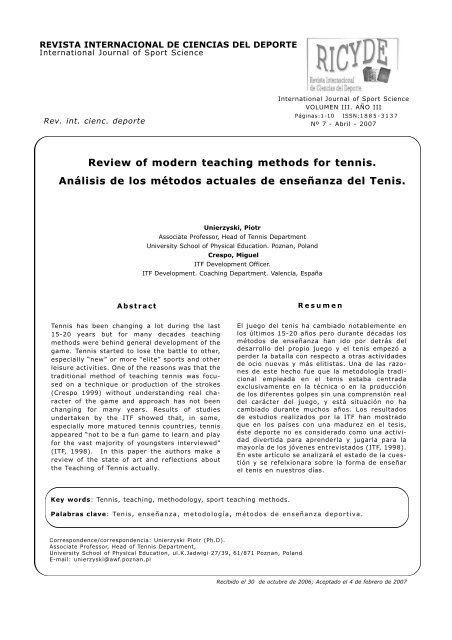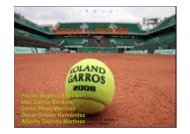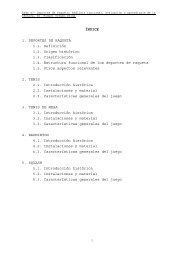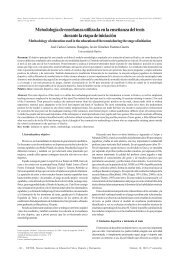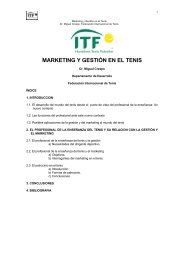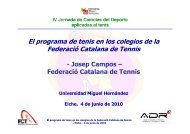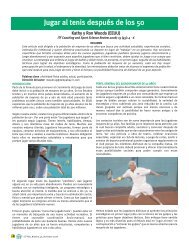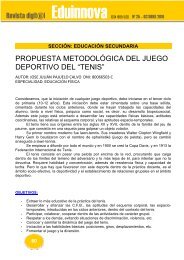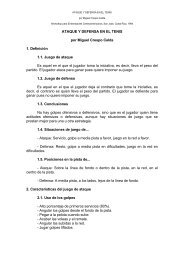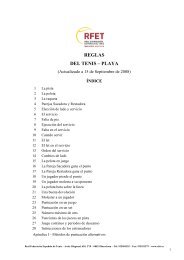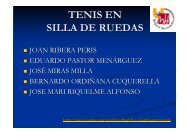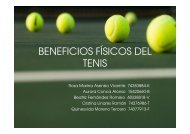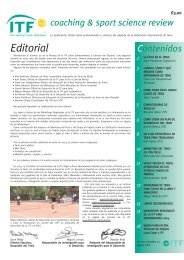Review of modern teaching methods for tennis ... - Miguel Crespo
Review of modern teaching methods for tennis ... - Miguel Crespo
Review of modern teaching methods for tennis ... - Miguel Crespo
You also want an ePaper? Increase the reach of your titles
YUMPU automatically turns print PDFs into web optimized ePapers that Google loves.
REVISTA INTERNACIONAL DE CIENCIAS DEL DEPORTEInternational Journal <strong>of</strong> Sport ScienceRev. int. cienc. deporteInternational Journal <strong>of</strong> Sport ScienceVOLUMEN III. AÑO IIIPáginas:1-10 ISSN:1885-3137Nº 7 - Abril - 2007<strong>Review</strong> <strong>of</strong> <strong>modern</strong> <strong>teaching</strong> <strong>methods</strong> <strong>for</strong> <strong>tennis</strong>.Análisis de los métodos actuales de enseñanza del Tenis.Unierzyski, PiotrAssociate Pr<strong>of</strong>essor, Head <strong>of</strong> Tennis DepartmentUniversity School <strong>of</strong> Physical Education. Poznan, Poland<strong>Crespo</strong>, <strong>Miguel</strong>ITF Development Officer.ITF Development. Coaching Department. Valencia, EspañaAbstractResumenTennis has been changing a lot during the last15-20 years but <strong>for</strong> many decades <strong>teaching</strong><strong>methods</strong> were behind general development <strong>of</strong> thegame. Tennis started to lose the battle to other,especially “new” or more “elite” sports and otherleisure activities. One <strong>of</strong> the reasons was that thetraditional method <strong>of</strong> <strong>teaching</strong> <strong>tennis</strong> was focusedon a technique or production <strong>of</strong> the strokes(<strong>Crespo</strong> 1999) without understanding real character<strong>of</strong> the game and approach has not beenchanging <strong>for</strong> many years. Results <strong>of</strong> studiesundertaken by the ITF showed that, in some,especially more matured <strong>tennis</strong> countries, <strong>tennis</strong>appeared “not to be a fun game to learn and play<strong>for</strong> the vast majority <strong>of</strong> youngsters interviewed”(ITF, 1998). In this paper the authors make areview <strong>of</strong> the state <strong>of</strong> art and reflections aboutthe Teaching <strong>of</strong> Tennis actually.El juego del tenis ha cambiado notablemente enlos últimos 15-20 años pero durante décadas losmétodos de enseñanza han ido por detrás deldesarrollo del propio juego y el tenis empezó aperder la batalla con respecto a otras actividadesde ocio nuevas y más elitistas. Una de las razonesde este hecho fue que la metodología tradicionalempleada en el tenis estaba centradaexclusivamente en la técnica o en la producciónde los diferentes golpes sin una comprensión realdel carácter del juego, y está situación no hacambiado durante muchos años. Los resultadosde estudios realizados por la ITF han mostradoque en los países con una madurez en el tesis,éste deporte no es considerado como una actividaddivertida para aprenderla y jugarla para lamayoría de los jóvenes entrevistados (ITF, 1998).En este artículo se analizará el estado de la cuestióny se refelxionara sobre la <strong>for</strong>ma de enseñarel tenis en nuestros días.Key words: Tennis, <strong>teaching</strong>, methodology, sport <strong>teaching</strong> <strong>methods</strong>.Palabras clave: Tenis, enseñanza, metodología, métodos de enseñanza deportiva.Correspondence/correspondencia: Unierzyski Piotr (Ph.D).Associate Pr<strong>of</strong>essor, Head <strong>of</strong> Tennis Department,University School <strong>of</strong> Physical Education, ul.K.Jadwigi 27/39, 61/871 Poznan, PolandE-mail: unierzyski@awf.poznan.plRecibido el 30 de octubre de 2006; Aceptado el 4 de febrero de 2007
Unierzyski, P.; <strong>Crespo</strong>, M. (2007). <strong>Review</strong> <strong>of</strong> <strong>modern</strong> <strong>teaching</strong> <strong>methods</strong> <strong>for</strong> <strong>tennis</strong>. Revista Internacional deCiencias del Deporte. 7(3), 1-10 http://www.cafyd.com/REVISTA/00701.pdfTIntroductionennis has been changing a lot during the last 15-20 years but <strong>for</strong> many decades <strong>teaching</strong><strong>methods</strong> were behind general development <strong>of</strong> the game. Tennis started to lose the battleto other, especially „new” or more “elite” sports and other leisure activities. One <strong>of</strong> thereasons was that the traditional method <strong>of</strong> <strong>teaching</strong> <strong>tennis</strong> was focused on a technique orproduction <strong>of</strong> the strokes (<strong>Crespo</strong> 1999) without understanding real character <strong>of</strong> the game andapproach has not been changing <strong>for</strong> many years. Results <strong>of</strong> studies undertaken by the ITFshowed that, in some, especially more matured <strong>tennis</strong> countries, <strong>tennis</strong> appeared “not to be afun game to learn and play <strong>for</strong> the vast majority <strong>of</strong> youngsters interviewed” (ITF, 1998). It isinteresting that similar problems occurred in Physical Education in developed countries likee.g. England and concerned some <strong>of</strong> traditional games (Werner et.al. 1996).Research showed that children, parents and coaches acknowledged that “games and game-likesituations were funnier than technically oriented drills” (Strean, Holt 2000). “Having fun” isthe most important motivator <strong>for</strong> children’s involvement in sport (Wankel & Kreisel 1985,Scanlan et.al. 1993,). At the same time “unequal playing time” is identified as one <strong>of</strong> the mainreasons <strong>of</strong> dropping out from practicing sport games (Pooley,1981).The research undertaken in UK (Bunker & Thorpe 1982) showed that under traditionalcoaching children were possessing poor decision making capacity, inflexible technique, knewvery little about games and were dependent on the coach. A need <strong>for</strong> alternative, more funnyway <strong>of</strong> practicing was widely identified (Hopkins 1975). Young people expected that the aim<strong>of</strong> <strong>teaching</strong> any game should be not only “improving per<strong>for</strong>mance” but also Werner et. al.(1996) improving their enjoyment and participation.Examples <strong>of</strong> world’s best athletes (especially in rackets sports and other ball games) showedthat many <strong>of</strong> them learned tactical and technical skills without a coach, just by playing withpeers, learning by doing (try and error), or imitating more successful friends. Stories <strong>of</strong> youngBrazilian footballers or American basketball players showed that learning both tactical andtechnical skills “by doing” instead <strong>of</strong> drilling is effective and certainly much more attractive<strong>for</strong> players. Findings <strong>of</strong> researches (e.g. Bunker & Thorpe 1982, Thorpe et. al. 1986, Thorpeand Dent 1999), observations <strong>of</strong> careers <strong>of</strong> many top <strong>tennis</strong> players and experience <strong>of</strong> themost successful coaches gave a base <strong>for</strong> a new <strong>teaching</strong> and training philosophy. Underleadership <strong>of</strong> the International Tennis Federation major nations <strong>for</strong>med own systems and usedown names but, the <strong>modern</strong> training <strong>methods</strong> follow similar philosophy and have manycommonalities. We believe that it is worth to investigating. The aim <strong>of</strong> the paper is to describethese commonalities and find out characteristic points, which make the “new” <strong>teaching</strong>philosophy so efficient.2
Unierzyski, P.; <strong>Crespo</strong>, M. (2007). <strong>Review</strong> <strong>of</strong> <strong>modern</strong> <strong>teaching</strong> <strong>methods</strong> <strong>for</strong> <strong>tennis</strong>. Revista Internacional deCiencias del Deporte. 7(3), 1-10 http://www.cafyd.com/REVISTA/00701.pdfCommon characteristics <strong>of</strong> <strong>modern</strong> <strong>teaching</strong> <strong>methods</strong>Adaptation to the game <strong>of</strong> <strong>tennis</strong> - game –based - tactical approach to coachingDespite the fact that different nations use different terms (e.g. Action Method, Game – BasedCoaching, Tactical Approach, GAG) the commonality is that <strong>teaching</strong> process takes intoconsideration the specific character <strong>of</strong> the game. A major shift in <strong>teaching</strong> methodology hasbeen the catalyst <strong>of</strong> structuring the <strong>teaching</strong> and coaching process with the idea <strong>of</strong> adapting itto the match situation—game based, and thus emphasising the role <strong>of</strong> strategy and tacticsalready in the initial stages <strong>of</strong> the game (tactical approach to coaching). While the ability toper<strong>for</strong>m a skill effectively is critical to per<strong>for</strong>mance, appropriate decisions concerning what todo in the game situation are equally important. There<strong>for</strong>e the aim <strong>of</strong> the Tactical Approach tocoaching <strong>tennis</strong> is to improve the overall game per<strong>for</strong>mance <strong>of</strong> the player combining tacticalawareness and skill execution (<strong>Crespo</strong> and Cooke 1999).The “new” methodology appeared to be successful not only in <strong>tennis</strong> but also has foundsupport among physical education practitioners in Europe and the USA (Griffin, et.al.1997;Turner et. al., 2001). Research (McPerson 1991, McPerson and French 1991, Turner 2003)confirmed that because <strong>of</strong> tactical (and game based) approach <strong>tennis</strong> players demonstratebetter game per<strong>for</strong>mance (shot precision and decision making) and have higher level <strong>of</strong>specific knowledge than players coached according to traditional approach. It is veryimportant to use modified games (Wright et. al. 2005), which engage pupils cognitively;stimulating pupil interest; allowing <strong>for</strong> more game play; and provide pupils the opportunity totransfer concepts from one game to another.This methodology may be used with players <strong>of</strong> different skills, from beginner topr<strong>of</strong>essionals. Level <strong>of</strong> technical skills is not a barrier, because (Thorpe 1992) it is possible tohave a good game with poor techniques. Because the criteria <strong>of</strong> success in practice are“wider” (traditionally success = the drill was well per<strong>for</strong>med) it is easier to create positivemotivational climate. Bunker & Thorpe (1982) proposed a curriculum, here presented inmodification by Holt – (2002), which also became a base <strong>for</strong> <strong>tennis</strong> training (fig 1.).3
Unierzyski, P.; <strong>Crespo</strong>, M. (2007). <strong>Review</strong> <strong>of</strong> <strong>modern</strong> <strong>teaching</strong> <strong>methods</strong> <strong>for</strong> <strong>tennis</strong>. Revista Internacional deCiencias del Deporte. 7(3), 1-10 http://www.cafyd.com/REVISTA/00701.pdfCurriculum ModelLearner – [cognitive, behavioraland effective domains]GameGame appreciationTactical awarenessDecision-MakingSkill ExecutionPedagogical PrinciplesSamplingModification-representationModification-exeggerationModification-representationModification-exeggerationPrinciples <strong>of</strong> playWhat to do / How to do it?Modification-representationModification-exeggerationModification-representationPer<strong>for</strong>manceFeedbackfromInstructorIncreasingTacticalComplexityFigure 1. Curriculum model <strong>of</strong> Game – based approach adapted by Holt (2002).In the game <strong>of</strong> <strong>tennis</strong> the methodology is based on assumption that at any given moment theplayer must be in one <strong>of</strong> 5 game situations (serving, receiving, playing at the back <strong>of</strong> theirown court with the opponent at the back <strong>of</strong> their court, approaching or at the net, playing atthe back <strong>of</strong> the court with the opponent approaching or at the net). In each <strong>of</strong> these situationsplayers per<strong>for</strong>m certain tactics e.g. keep the ball in play, try to move the opponent around, useown strengths etc (Tennant 2004). Players are doing two things at the same time - they are inparticular game situation and they are in a basic tactical situation. There<strong>for</strong>e the goal <strong>of</strong>coaching process in all <strong>modern</strong> <strong>methods</strong> round the world is to teach how “to deal” in these 5situations.The priority <strong>for</strong> the players is to understand the game, develop a game sense and learnpractical competences e.g. how to attack the net, not just how to hit “nice” shots. Important isthat students rally (even if, at the beginning it is a “self rallying”, without a net) and, sametime learn how to solve different tactical problems. Coaches working according to thismethodology first try to develop cognitive skills and later, if necessary, they use technique,closed drills. So the topic/tactical problem <strong>of</strong> the lesson might be “Setting up to attack bycreating space on opponent’s court” and creating space using ground strokes (not just workingon cross court <strong>for</strong>ehand). In this approach to coaching the classical Analytic Methods (thestrokes were broken into parts) became less important.4
Unierzyski, P.; <strong>Crespo</strong>, M. (2007). <strong>Review</strong> <strong>of</strong> <strong>modern</strong> <strong>teaching</strong> <strong>methods</strong> <strong>for</strong> <strong>tennis</strong>. Revista Internacional deCiencias del Deporte. 7(3), 1-10 http://www.cafyd.com/REVISTA/00701.pdfThe priority <strong>of</strong> tactics over technique does not mean that coaches must not work on shots –better technique gives a player more tactical options but it was found out that technique taughtglobally, in certain tactical context and with the use <strong>of</strong> adapted size <strong>of</strong> the court was not onlymore attractive but also more efficient.Holistic approach to coachingWhen dealing with players it is important to recognise that it is more important to get theplayer to learn the skill and be able to per<strong>for</strong>m it in the right context rather than to simplyteach the technique.Modern <strong>tennis</strong> training takes into account the importance <strong>of</strong> <strong>tennis</strong> as a whole, a holisticapproach to coaching, and the principle <strong>of</strong> integration vs. isolation. The relevance <strong>of</strong> a holisticview <strong>of</strong> <strong>tennis</strong> coaching is gaining more and more recognition worldwide and is promoted bymajor <strong>tennis</strong> associations. Terms like “integrated, total or complex” <strong>tennis</strong> training are veryclose to each other are more common among coaches <strong>of</strong> all levels. These terms refer to aglobal vision <strong>of</strong> <strong>tennis</strong> training in which all components are integrated and are put intopractice using a “complex” training approach. The concept <strong>of</strong> integrated training <strong>for</strong> <strong>tennis</strong>states that the traditional distinction between technique, tactics, conditioning, and mentality ismore artificial than real. It is practically applied following the principle that when working ontechnical aspects, players are also working tactics, conditioning, mentality, and vice versasince there is an interrelation and interdependence between all <strong>of</strong> them. That is why a lessonshould have a versatile character its goals should concern more that just tactics and technique.A good coach will implement aims concerning motor and mental development in almostevery lesson (<strong>Crespo</strong> 1999, Schönborn 1999).Player centred coaching, goal (skills)-oriented learningModern coaching is also player centred and individualised. It fully recognises the player asthe centre <strong>of</strong> the coaching process and all ef<strong>for</strong>ts should be made to provide the bestassistance possible to help the player achieve his goals. Educating a person as a whole,<strong>teaching</strong> not just techniques but also skills and ability to solve the problem.Coaches spent more work on creating initiative and creativeness (tactical thinking). Winningin children/junior categories is not that much important as reaching planned step by step,training goals and the general development <strong>of</strong> a player. There<strong>for</strong>e the role <strong>of</strong> a coach in<strong>modern</strong> sport is different, A coach should be more a guide, who creates positive motivationalclimate, rather than being an authoritarian. Players are taught to be more independent; they<strong>of</strong>ten find “own way” and learn from their? success.” A study done in Sweden (Thrope &Dent 1999) ) indicated that Swedish players who made it to the top as adults, had childhoods’that were typified by play and practice in a supportive atmosphere, rather than intensivecoaching. The philosophy laying behind the most successful programs means also Goal(skills)-and development - oriented learning –not a result oriented. There<strong>for</strong>e mediationalapproach to <strong>teaching</strong> and correcting technique and democratic style <strong>of</strong> coaching are usedmuch more than be<strong>for</strong>e and it is exactly what athletes expect (Chelladurai 1984, Martin et. al.1999, Amorose 2000).5
Unierzyski, P.; <strong>Crespo</strong>, M. (2007). <strong>Review</strong> <strong>of</strong> <strong>modern</strong> <strong>teaching</strong> <strong>methods</strong> <strong>for</strong> <strong>tennis</strong>. Revista Internacional deCiencias del Deporte. 7(3), 1-10 http://www.cafyd.com/REVISTA/00701.pdfWide use <strong>of</strong> sport science and technology, preventive / injury freeModern coaching is sport science coaching. It is impossible to understand the coachingprocess at any <strong>tennis</strong> level without a sound sport science basis, which implies the use <strong>of</strong> thesport science fundamentals in the daily coaching. Sport science provides <strong>tennis</strong> coaching witha much better understanding <strong>of</strong> almost all aspects <strong>of</strong> the game since major scientificcontributions have helped to develop coaching theories and education. The progressivedevelopments in sports medicine, <strong>tennis</strong> technology, psychology, training theory and othermajor sport sciences are having a major impact in the delivery <strong>of</strong> injury free trainingprogrammes <strong>for</strong> players <strong>of</strong> all ages and playing levels. This is the reason why sport sciencehas become a major part <strong>of</strong> the coach education programmes worldwide. The challenge isnow <strong>for</strong> sport science to become a major part <strong>of</strong> the player training programmes <strong>of</strong> all nations,not only <strong>for</strong> leading ones.Development <strong>of</strong> coordination as a base <strong>of</strong> technique and the main motor ability to beimprovedAs far as coordination is concerned <strong>tennis</strong> is one <strong>of</strong> the most demanding sports. Because everyincoming ball is different, reaching it on time and hitting it back effectively requires welldeveloped coordination skills. That is why it is a base <strong>for</strong> developing technical skill andoptimal use <strong>of</strong> other motor abilities as speed and strength. Learning <strong>of</strong> “final” technique(Schönborn 1999) must be preceded by developing <strong>of</strong> general, specific coordination andgaining skills similar to <strong>tennis</strong> (like catching or throwing). Another important matter is that inall major <strong>methods</strong> it is aimed to teach both reception (ability to judge correctly the flight <strong>of</strong>the ball and move to the position to play particular shot) and projection (ability to develop thetechniques) skills (ITF Coaches Manual 1994). If development <strong>of</strong> coordination is messedduring mini <strong>tennis</strong> stage it is very difficult to catch up (Pankhurst 2003). Because <strong>of</strong> itsimportance all federations emphasise the need to work on different aspects <strong>of</strong> coordination notonly on every lesson, not only during the warm up.Functional and biomechanical approach to movementsAdopting “the new methodology” does not mean that the role <strong>of</strong> biomechanics and techniquein players’ development is less important than be<strong>for</strong>e. Effective implementation <strong>of</strong> strategyand tactics requires <strong>tennis</strong> – specific (technical) skills (Thorpe & Bunker 1997, <strong>Crespo</strong> & Reid2003). In today’s <strong>tennis</strong>, technique (the action) is seen as a function <strong>of</strong> the correctbiomechanical principles and as means to implement tactics more efficiently. Each movementshould be treated as a tool useful to solve tactical problem. Consequently, the perfect (model)stroke does not exist; “strict imposition <strong>of</strong> certain grips, stances, backswings and followthroughsis not recommended <strong>Crespo</strong> & Reid (2003). The goal <strong>of</strong> technical development is tostructure an individualised model <strong>of</strong> per<strong>for</strong>mance and every player has a right to executestrokes individual way but with the respect <strong>of</strong> biomechanical principles. Looking from thisperspective the success in <strong>teaching</strong> means respecting individuality and laws/rules (e.g. <strong>of</strong>biomechanics).6
Unierzyski, P.; <strong>Crespo</strong>, M. (2007). <strong>Review</strong> <strong>of</strong> <strong>modern</strong> <strong>teaching</strong> <strong>methods</strong> <strong>for</strong> <strong>tennis</strong>. Revista Internacional deCiencias del Deporte. 7(3), 1-10 http://www.cafyd.com/REVISTA/00701.pdfThe procedure known in coaches jargon as open-closed-open (Pankhurst 1999) or globalanalytic-global(GAG - Maier 1999) became very useful in enhancing both technical andtactical skills easier, faster and more attractive way. The use <strong>of</strong> the mediational learningtechnique in correcting players corresponds with this approach.The beginner has to deal and become familiar with new, equipment - a racket and a ball.Using the right equipment supports the learning process; low compression <strong>tennis</strong> balls,reduced-size rackets and courts make the game easier to play from the first lesson, develop anall court all stroke game, promote the use <strong>of</strong> the correct techniques and reduce risk <strong>of</strong> injury.The need to scale down sports equipment, field dimensions and rules was raised already manyyears ago (Dept. <strong>of</strong> Leisure, Sport and Tourism 1983). Mini <strong>tennis</strong> was born in <strong>for</strong>merCzechoslovakia in 1960’s and has been widely used in many countries. Which is relativelynew, the integration <strong>of</strong> methodology and equipment used during certain stages <strong>of</strong> learning isemphasised. Major <strong>tennis</strong> federations put more importance on coordinating methodology withthe equipment and facilities. They usually divide the learning process into stages andrecommend adjusting size <strong>of</strong> courts, rackets and balls to skills, mental and physicalcapabilities <strong>of</strong> players much more than be<strong>for</strong>e.The methodology uses the natural feature <strong>of</strong> human being, which is the ability to adjust tosituation. Creating certain situation, coaches support the training goal(s) they encouragepupils to use angle shots as a result <strong>of</strong> making court wider. or vice versa: making the courtvery narrow and relatively short encourage students to approach the net more <strong>of</strong>ten.The logical result <strong>of</strong> this approach is divides the learning process into stages. The names aredifferent; e.g. mini-<strong>tennis</strong> red-orange-green or micro- mini-midi-maxi <strong>tennis</strong> but the purposeis the same: making the game more af<strong>for</strong>dable (in methodological sense) <strong>for</strong> beginners.Because, at the beginning, children start to play from a small distance, the movements aremuch shorter that regular ones. Reducing court size means reducing strokes. At the beginningchildren learn just a main phase <strong>of</strong> each stroke, later core <strong>of</strong> all movements, and slowly, stepby step they <strong>for</strong>m own strokes. So strokes, very “small” at the beginning, “grow up” with ageand competences <strong>of</strong> players. This process last a few years. Generally there is a tendency topostpone the moment <strong>of</strong> playing on regular court. Majority <strong>of</strong> federations use Midi <strong>tennis</strong>programs (court 18 m long) as a transition between mini- <strong>tennis</strong> (in UK Mini Tennis Red) andplaying on regular court. Generally it is agreed that only extremely gifted player may start toplay regularly on full court be<strong>for</strong>e the age <strong>of</strong> 10.Promotion and marketing activitiesIn reality <strong>of</strong> <strong>modern</strong> world possessing best product is not enough. It is equally vital topromote it. There<strong>for</strong>e top <strong>tennis</strong> nations combine educational and promotion activities, in thatcase among players, parents and coaches. It is especially important to educate and encouragecoaches to learn and use new methodology. The research show that GBA has found”considerable support among physical education practitioners in Europe and the UnitedStates” (Griffin, et.al., 1997; Turner, 2001), but at he same time in every country there is agroup <strong>of</strong> “experienced” coaches, who have been using a technical approach <strong>for</strong> many yearsand find difficult to change their mentality.7
Unierzyski, P.; <strong>Crespo</strong>, M. (2007). <strong>Review</strong> <strong>of</strong> <strong>modern</strong> <strong>teaching</strong> <strong>methods</strong> <strong>for</strong> <strong>tennis</strong>. Revista Internacional deCiencias del Deporte. 7(3), 1-10 http://www.cafyd.com/REVISTA/00701.pdfOne <strong>of</strong> the best examples <strong>of</strong> promotional activities are systems <strong>of</strong> awards. Many nations useAwards system (or like e. in Switzerland Kids Tests), series <strong>of</strong> progressive exercises whichhelp children to learn skills, and coaches to sort players by ability. The idea <strong>of</strong> the system isthat children are rewarded <strong>for</strong> being able to per<strong>for</strong>m certain, progressive exercises. Rewardsdiffer from country to country, in some (e.g. UK) children collect stickers as rewrds <strong>for</strong>certaing achievement, in other they get bronze-silver and gold medals (similarly to OlympicGames) on each stage. Receiving gold medal mean that the child is ready to start practicing onnext stage. Such systems motivate players to learn new skills and go to next learning stagefaster (similarly to computer games or belts in judo) but are also strong marketing tools.COURTlength x widthMICRO“PRE TENNIS”MINI“RED”MIDI“ORANGE”0-4 x 2-4 m 6-12 x 4-6 m 12/18 x 5,5-8,24mMAXI“GREEN”23,77 x 8,24mNET 60-80 cm 80cm 80/ 91,4cm 91,4cmBALLsponge or „red”, max. 36- 45gmax. 41-50,5g„Orange”<strong>for</strong> 10- “green”from 11 years -regularRACKET17-19 inch43 -48 cm19-23 inch48- 58 cmto 25 inch58 -63 cm10 years: max. 26 inch (66cm) 11 years: freeAGEUsually 3-6Up to 8 yrs.6-7 only whenpass award9/10 yrs. 8-9 yrs„WC” fromregional coachfrom 10 or 11 years9 -10 when „WC” fromnational coachCOMPETITIONSFORMULASCORING(examples)No <strong>of</strong>ficialcompetitions2 sets up to 9pointsRound robin (e.g.6 plrs), no finalwinner2 Sets up to 4games, tiebreak at3-3. Round robin(4 plrs)No.KO2 ‘short set’ to 4 with tiebreak at 4-4Round robin (4-3 plrs) orKO till 2 defeats in singlesand doublesLENGTH OFCOMP./MATCHES2-3 hrs/7-10mins3 hrs15-20mins3-4 hrs/20-35minsTable 1. Summary <strong>of</strong> common characteristics <strong>of</strong> <strong>modern</strong> <strong>teaching</strong> <strong>methods</strong> <strong>for</strong> <strong>tennis</strong>SummaryDespite obvious national differences <strong>teaching</strong> methodologies <strong>of</strong> leading countries followsimilar philosophy, which make the game attractive, especially to young generation. Thecommonalities in organisation <strong>of</strong> major system are presented in the table.New ideas came very fast into life and already after 2-3 positive results can be noticed. Looksthat because <strong>of</strong> dynamic action taken by the ITF and leading <strong>tennis</strong> nations the crisis <strong>of</strong> thegame in developed <strong>tennis</strong> nation was stopped. We believe that it is a good moment to increasepromotional activities and spear <strong>modern</strong> <strong>teaching</strong> methodology around the Racket SportWorld.8
Unierzyski, P.; <strong>Crespo</strong>, M. (2007). <strong>Review</strong> <strong>of</strong> <strong>modern</strong> <strong>teaching</strong> <strong>methods</strong> <strong>for</strong> <strong>tennis</strong>. Revista Internacional deCiencias del Deporte. 7(3), 1-10 http://www.cafyd.com/REVISTA/00701.pdfBibliographyAmorose, A.J. (2000). Intrinsic motivation: relationships with collegiate athletes' gender,scholarship status, and perceptions <strong>of</strong> their coaches' behavior. Journal <strong>of</strong> sport &exercise psychology, 22 (1)Bunker, D. J., & Thorpe, R. D. (1982). A model <strong>for</strong> the <strong>teaching</strong> <strong>of</strong> games in SecondarySchools. Bulletin <strong>of</strong> Physical Education, 18(1), 5-8.Chelladurai, P. (1984). Discrepancy between preferences and perceptions <strong>of</strong> leadershipbehavior and satisfaction <strong>of</strong> athletes in varying sports. Journal <strong>of</strong> Sport Psychology, 6,27-41.<strong>Crespo</strong> M. and Cooke K. (1999). The Tactical Approach to Coaching Tennis. ITF Coaches<strong>Review</strong>, Issue 19, 7-8.<strong>Crespo</strong>, M. (1999). Teaching Methodology <strong>for</strong> Tennis. ITF Coaches <strong>Review</strong>, 19,3-4.<strong>Crespo</strong>, M., and Reid M. (2002). Modern tactics: an introduction. ITF Coaching & SportScience <strong>Review</strong>. 27,2.<strong>Crespo</strong> M., and Reid M. (2003) Biomechanics and Teaching Methodology. In: Elliott,B.,Reid, M., and <strong>Crespo</strong>., M.( eds.). ITF Biomechanics <strong>of</strong> Advanced Tennis. TheInternational Tennis Federation.Dept. <strong>of</strong> Leisure, Sport and Tourism (1983). Sport: are children little adults?. Sydney:Dept. <strong>of</strong> Leisure, Sport and Tourism.Meier M. (1999). The GAG Method. ITF Coaches <strong>Review</strong>, Issue 19, 15.Griffin, L. L., Mitchell, S. A., & Oslin, J. L., (1997). Teaching sport concepts and skills: Atactical games approach. Champaign, IL, Human Kinetics.Holt, N. L., Strean, W. B. & Bengoechea, E. G. (2002). Expanding the <strong>teaching</strong> games <strong>for</strong>understanding model: new avenues <strong>for</strong> future research and practice. Journal <strong>of</strong>Teaching in Physical Education, 21, 162–176.Hopkins, P.D. (1975). A Child's Model <strong>for</strong> Adult Games: A Viable Alternative. Unpublishedpaper.ITF Coaches Manual. (1994). International Tennis Federation.ITF (1998). Tennis towards 2000. ITF Ltd. London.Martin, S.B.; Jackson, A.W.; Richardson, P.A. & Weiller, K.H. (1999). CoachingPreferences <strong>of</strong> adolescent youths and their parents. Journal <strong>of</strong> Applied SportPsychology,11,247-262.McPherson, S. L.(1991). Changes in knowledge content and structure in adult beginner<strong>tennis</strong>: a longitudinal study. Paper presented at the annual meeting <strong>of</strong> the NASPSPA.Pittsburg USA.McPherson, S. L. & French, K. E. (1991). Changes in cognitive strategies and motor skillin <strong>tennis</strong>. Journal <strong>of</strong> Sport and Exercise Psychology, 13, 26–41.Pankhurst A. (1999.) Game Based Coaching. ITF Coaches <strong>Review</strong>, Issue 19, 11-13Pankhurst A., (2003). Presentation from Polish Coaches Symposium. 24 April 2003.Pooley, J.C. (1981).Drop-Outs From Sport: A Case Study <strong>of</strong> Boys Age Group Soccer.American Alliance <strong>for</strong> Health, Physical Education, Recreation and Dance. Ninety-sixthNational Eastern District Convention. Boston, Massachusetts. (pp 32. April 13-17).9
Unierzyski, P.; <strong>Crespo</strong>, M. (2007). <strong>Review</strong> <strong>of</strong> <strong>modern</strong> <strong>teaching</strong> <strong>methods</strong> <strong>for</strong> <strong>tennis</strong>. Revista Internacional deCiencias del Deporte. 7(3), 1-10 http://www.cafyd.com/REVISTA/00701.pdfScanlan, T.K., Carpenter, P.J., Lobel, M., & Simons, J.P. (1993). Sources <strong>of</strong> enjoyment <strong>of</strong>youth sport athletes. Journal <strong>of</strong> Pediatric Exercise Science, 5, 275-285.Schönborn R. (1999). Advanced Techniques <strong>for</strong> competitive <strong>tennis</strong>. Mayer and Mayer.Stean, W.B. and Holt.,N.L.(2000).Players’, coaches, and parents’ perceptions <strong>of</strong> fun inyouth sport. Avante, 6, 84-98.Tennant M. (2004). The Five Game Situations in Mini-Tennis. ITF Coaching & SportScience <strong>Review</strong> 32,7-9.Thorpe, R.D. (1983.) “An understanding approach to the <strong>teaching</strong> <strong>of</strong> <strong>tennis</strong>”. Bulletin <strong>of</strong>physical Education.10(1), 12-19.Thorpe, R.D., Bunker, D.J.,Almond, L. (1986). A change in the focus <strong>of</strong> <strong>teaching</strong> games.In:Pieron, M.,&Graham, G.,(Eds.), Sport Pegagogy: Olympic Scientific CongressProceedings.,Vol.6(pp. 163-169).Champaing,Il; Human Kinetics.Thorpe, R.D., Bunker, D.J.,Almond, L. (1986).Rethinking games <strong>teaching</strong>. Loughbough,UK Loughbough, University.Thorpe, R.D.(1992). The Psychological factors underpinning the “<strong>teaching</strong> <strong>for</strong>understanding games” games movement. In: T.Williams, L.Almond, & A.Sparkes(Eds.), Sport and Physical Activity: Moving toward excellence. (pp. 209-218).London:E& FN Spon.Thorpe, R.D.& Bunker, D.J. (1997). A changing focus in games <strong>teaching</strong>. In: L.Almond(ed.), Physical education in schools (pp.52-80). London: Kogan Page.Thorpe, R.D. & Dent P. (1999). Developing a more Player Oriented Approach to CoachingTennis. ITF Coaches <strong>Review</strong>,19,5-7.Turner, A. P. & Martinek, T. J. (1995). Teaching <strong>for</strong> understanding: A model <strong>for</strong>improving decision making during game play. Quest, 4, 44-63.Turner, A. P., & Martinek, T. J. (1999). An investigation into <strong>teaching</strong> games <strong>for</strong>understanding: Effects on skill, knowledge and game play. Research Quarterly <strong>for</strong>Exercise and Sport, 70 (3), 286-296.Turner, A. P., Allison, P. C., & Pissanos, B. W. (2001). Constructing a concept <strong>of</strong>skillfulness in invasion games within a games <strong>for</strong> understanding context. EuropeanJournal <strong>of</strong> Physical Education, 6 (1), 38-54.Turner, A. P. (2001). “Touch rugby: A tactical twist”. Teaching Elementary PhysicalEducation, 12 (1), 12-16.Turner A., <strong>Crespo</strong>, M., Reid, M., and Miley, D. (2001) The Games <strong>for</strong> understanding(GFU) Teaching Approach in Tennis. ITF Coaches <strong>Review</strong>, 26, -4.Turner A. (2003). A comparative analisis <strong>of</strong> two approaches <strong>for</strong> <strong>teaching</strong> <strong>tennis</strong>: Gamebased Approach versus Technique Approach. Paper presented at the 2 nd ITF Tenisscience and technology Congress. London.Wakel, L.M.,& Kreisel,P.S.J. (1985). Factors underlying enjoyment <strong>of</strong> youth sport. Journal<strong>of</strong> Sport Psychology,7,51-64.Werner, P., Bunker, D.J., &Thorpe, R.D. (1996).Teaching games <strong>for</strong> understanding:Evolution <strong>of</strong> a model. Journal <strong>of</strong> Physical Education, Recreation and Dance,67(1),28-33.Wright Steven, McNeillb Michael, Fryb Joan and Wang John. (2005). Teaching teachers toplay and teach games. Physical Education and Sport Pedagogy. Vol. 10, 1, 61–82.10


